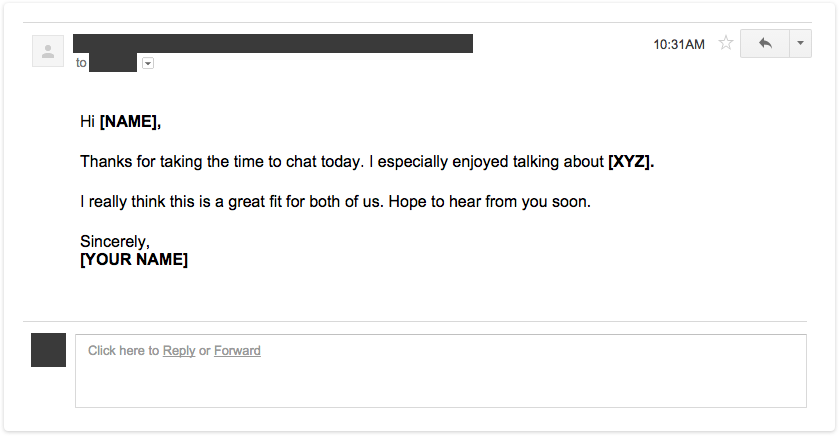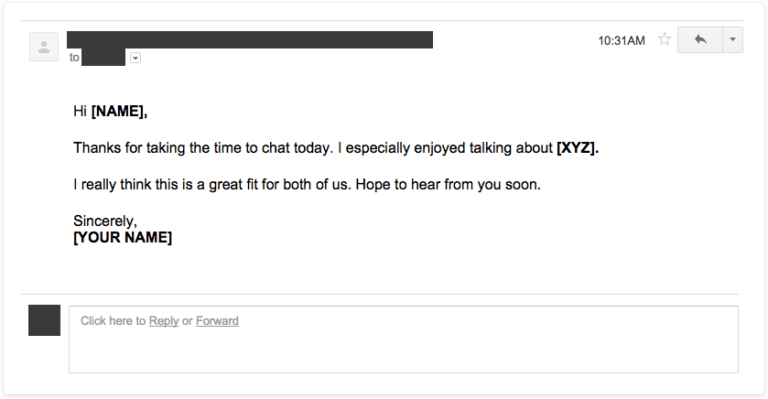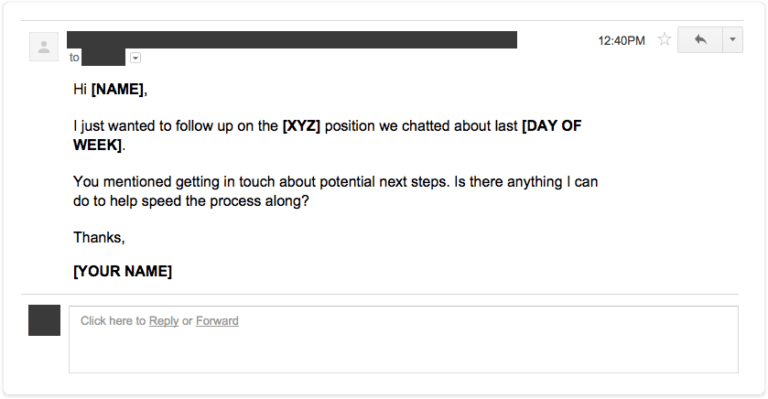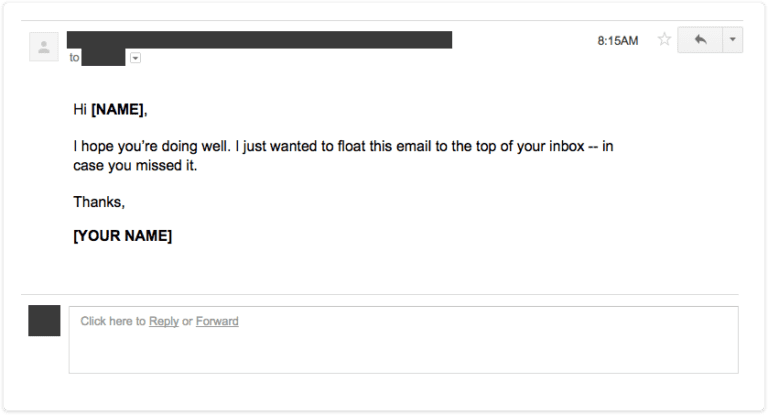The best thing you can do to improve your chances of landing the job: Sending an interview follow-up email.
If you’re in a hurry, here is a quick example of a perfect follow-up email:

Not only does it show you’re courteous, but also that you’re willing to take action for your job.
But if you want to send a follow-up email that REALLY gets their attention, there’s a bit more to it. Keep reading and I will show you how.
How to Send the Perfect Follow-up Email
I want to show you a three-step system for following up that goes beyond a single email. When you do this right, it will instantly make you the clear favorite for any job you’re after.
Step 1: Collect Contact Information Before You Need It
After the interview and before you even consider rushing home to draft that perfect follow-up email, make sure you do one thing: Grab the business cards or contact information of everyone you spoke to.
And I. Mean. EVERYONE.
Was there someone who screened you on the phone before you got the interview? Get their email.
Was there a panel of interviewers? Get all of their contact info.
Did a receptionist escort you to a waiting area and grab you a glass of water before your interview? Grab her business card too.
I can’t think of a single employer who wouldn’t LOVE it if their receptionist told them about the awesome interviewee who emailed them to thank them for helping them that day. They could also be your future coworker, so it’s an easy way to start building a great relationship.
The little details go a long way when it comes to the follow-up.
Step 2: Craft the Perfect Follow-Up (with scripts)
There are two ways you can approach your follow-up email and the pros and cons of each:
Send the hiring manager a physical card or letter
- Pros: Receiving a physical message is incredibly novel in this day and age — and this could set you apart even more from the rest of the applicants.
- Cons: It’s not as fast as sending an email — and you’re going to want to send the follow-up as soon as possible after the interview. If they are moving fast, your note may arrive too late.
Write an email to them
- Pros: It’s quick, easy, and allows you to send to multiple people with one message (pro-tip: write one really great follow-up, then copy and edit it for each person you spoke to).
- Cons: It’s more impersonal and there’s also the chance that your message is lost in their inbox or spam folder. Sending the exact same letter to everyone could backfire.
In the end, though, it doesn’t matter which method you choose as long as you do it.
When you do, here’s that first script from earlier that you can use to follow up with the interview manager:
The initial follow-up email (send ASAP):

Here’s the email written out so you can copy and paste the template:
Hi [NAME],
Thanks for taking the time to chat today. I especially enjoyed talking about [XYZ].
I really think this is a great fit for both of us. Hope to hear from you soon.
Sincerely,
[YOUR NAME]
This example is for an email — but you can easily use it for a physical card too.
Notice three key things about this email:
- It’s a short, simple message. Your follow-up message doesn’t need to be fancy or complicated. In fact, making it too long will either bore the hiring manager or make them think you’re desperate.
- It’s specific. Be sure to get specific about the details. Bring up something that you actually enjoyed talking about in the interview. These details will trigger the hiring manager’s memory and help make a great, lasting impression.
- It should be sent as quickly as possible. Aim to send your email within two hours of your interview. This will show your enthusiasm, and it’ll be easier for you to remember all the details you should include.
Advanced tip: The best people in every field automate as many areas of their lives as possible. You can automate your interview follow-up email if you want to save some time and ensure it gets sent. You can do this by creating a draft of your follow-up email before you even go to the interview.
That way after it’s done, you can simply open the draft, fill in the missing details, and hit “send.” Boom. You’re done and can spend more time focusing on the Big Wins in your life.
Step 3: Follow-up
Don’t sweat it and be patient. It may take the hiring manager several days or weeks to interview the other applicants and make a decision.
If you have not heard a response after a few days, you can send another follow-up email to check in.
Use this gentle email template to nudge them along:
The nudge email (after a few days):

Here’s the email written out so you can copy and paste the template:
Hi [NAME],
I just wanted to follow up on the [XYZ] position we chatted about on [DAY OF WEEK].
You mentioned getting in touch about potential next steps. Is there anything I can do to help speed this process along?
Thanks,
[YOUR NAME]
Notice how this email is short and gets right to the point. It uses a light touch but still lets them know you’re interested in the job.
It’s also important that this email doesn’t make the recipient feel guilty for not replying sooner. If you make them feel that way, a follow-up will backfire on you and you could lose the opportunity altogether.
The most likely thing is that they’re just busy or your first message got lost in the inbox. This email will grab their attention and bring your interview back to the top of their mind.
After that, wait one more week before sending your next, and final, response.
Advanced tip: Be sure to download a tracking app, such as HubSpot’s email tracking tool, that lets you know exactly when your interviewer opens your follow-up message. The tool notifies you the moment they see your email, so you’ll be able to follow up right then while you’re fresh on their minds.
Doing this is key because it’s not disruptive since they’re already reading your email and saves both you and the interviewer time.
Check out this episode from the IWT Podcast 👇
“My wife doesn’t want me to take a $720k job offer”
When to Call it Quits on Following Up
If you still haven’t heard back a week later, reply to your previous interview follow-up email, saying this:
The bump email (after a week of no response):

Here’s the email written out so you can copy and paste the template:
Hi [NAME],
I hope you’re doing well. I just wanted to float this email to the top of your inbox — in case you missed it.
Thanks,
[YOUR NAME]
If they’re interested, they’ll get back to you. If they still don’t reply, it’s probably safe to assume they’ve chosen someone else for the role.
If that’s the case, don’t beat yourself up. It happens to everyone at some point. Go back to the job search — and prepare even better next time.
BONUS: Closing the Loop technique
As an extra for you, I want to show you a fantastic system to help you:
- Stay in touch with VIPs
- Transform one-time meetings into long-term relationships
- Showcase your value to anyone
This goes beyond your typical follow-up “thanks for your time” email — and answers the question, “How do I make the person I just met want to help me?”
Introducing the Closing the Loop Technique.
This is a series of three emails you send to the person you just met with that’ll almost ensure they’ll want to keep in touch with you.
Here are the emails complete with my breakdown of why they work.
Email #1: Thank you (same day)
Hi Amy,
Just wanted to thank you again for meeting with me earlier. I’m definitely going to get in touch with Susan as you recommended. I’ll keep you in the loop, and of course, please let me know if there’s anything I can do to repay the favor!
John
A few things to note: First, the thank you is simple. No need to spill more ink than you need to.
It also references a specific action item you’re going to follow up on. This shows the person you’re emailing that you were paying attention during the interview.
The email ends with a solid offer from you to help in any way you can — while asking nothing of the recipient.
…but you don’t have to take the same path as everyone else. How would it look if you designed a Rich Life on your own terms? Take our quiz and find out:
Why Sending a Follow-up Email is a Critical Step
It doesn’t matter how good your interview was — you STILL need to send a follow-up email for five reasons:
- It leaves a good impression. And impressions are everything when it comes to getting a job.
- The hiring manager will remember you. You were likely one of several interviews conducted by the company. Don’t get lost in the fray. There’s no better way to keep you on the hiring manager’s brain than by sending a follow-up email.
- You show that you have initiative. When you go out of the way to send an after-interview email, it shows that you’re willing to go above and beyond to make a lasting impression.
- The company will see that you’re genuinely interested. The follow-up email is a good way to separate you from the other interviewees who most likely didn’t even think to loop back with them.
- Interview follow-up emails work. Your chances of getting the job go way up if you send a follow-up email. Especially if you are neck-and-neck with another candidate.
Imagine you’re in the process of hiring and you have two potential candidates. Both are equally qualified for the role and interviewed well — but only ONE of them sent you a follow-up message thanking you for your time and calling back to some points you made that really made an impact on them.
Who do you think you’re going to pick for the job?
Answer: THE PERSON WHO SENT YOU THE FOLLOW-UP MESSAGE!!
It’s important to also keep in mind that your interviewer’s reputation is on the line.
This is key, so I’m going to say it again.
Your interviewer’s reputation is on the line.
Based on the few minutes they interact with you, your interviewer has to make a lot of important assessments. Do you have the right skills? Will you fit with the company culture? Are you reliable and trustworthy? etc.
It’s like speed-dating on steroids — with one major exception. If they judge you incorrectly, they don’t just risk an awkward second date. They risk their boss questioning their judgment for the rest of their career.
And if it doesn’t work out, they have wasted months of time and thousands of dollars. They need to get this right. Not just for YOU but for THEM.
It’s important to keep this in mind when you go into an interview.
Your success is in their best interest. And when you follow up correctly after an interview, you make their job easier by proving you’re a Top Performer who deserves the job.
Email #2: Add value (1 – 2 weeks later)
Hey Amy,
Saw this article in the Wall Street Journal and it reminded me of what you said about productivity tests! No response needed, just thought you might find it interesting.
John
Now we start to shake things up. The person you’re emailing likely wasn’t expecting to ever hear back from you again. They especially weren’t expecting you to send something of value to them.
This can be anything — a blog post, email newsletter, YouTube video — as long as you know they will find it interesting.
How do you know this? Because during your meeting, you listened to what they said and noted the things that piqued their interest.
Pay close attention to the phrase used in the last sentence: “No response needed.” This is music to a busy person’s ears. Think about it: I get 600+ emails/day, and do you know what most of them want? They want something from me. When you can say “No response needed,” and send me something I find fascinating, you’re adding value to my life.
Email #3: Close the loop (2 – 3 weeks later)
Hi Amy,
Wanted to give you an update: I did end up talking to Susan, and you were right — Acme is definitely a fit for me. I’m reaching out to a friend there to learn all I can about Acme before I apply. If there’s anyone else you think I should speak to, please let me know.
Thanks again! I’ll let you know how it goes.
John
Now is when you separate yourself from 99.999% of people by showing the person you’re emailing that you actually took action on what they suggested.
If you give specific names of people and companies, that’ll show you were listening. It’ll also show the person you’re emailing that they were right — which is a major psychological boost for them.
Just like my Briefcase Technique, this system seems simple and obvious — until you use it. Then its true power is revealed.
And it’s incredibly effective. Check out this email I got from a reader who used the Closing the Loop Technique to help him get a job.
Hey Ramit,
One more testimonial to the Closing The Loop technique that you taught last night. I reached out to a prior boss I haven’t seen in 4 to 5 years about a position I heard about at that company. All I had asked for was if I could still use him as a reference and his up-to-date contact info. He responded in less than a half-hour. By following up and offering to keep him in the loop, he then responded with an offer for a letter of recommendation and an offer to send a personal email to the hiring manager on my behalf. Holy Crap! It really works…
-Greg H.
For more on this, be sure to check out my five-minute video where I break down this technique.
FAQs About How to Write an Interview Follow-Up Email
What should I do if I don’t have the interviewer’s email address?
If you don’t have the interviewer’s email address, you can try to find it online by searching the company’s website or LinkedIn. If you still can’t find it, you can reach out to the recruiter or HR representative who scheduled the interview and ask for the interviewer’s contact information. If all else fails, you can send a thank-you note or follow-up message through the LinkedIn platform or the company’s website.
Is it okay to ask for feedback in the follow-up email?
Yes, it’s okay to ask for feedback in a follow-up email after an interview. However, it’s important to be polite and respectful in your request and to not come across as pushy or entitled. You can simply ask if the interviewer has any feedback or suggestions for how you can improve your skills or interview performance in the future.
How often should I follow up if I don’t hear back?
If you don’t hear back after an interview, it’s generally best to follow up once about a week or two after the interview. If you still don’t receive a response after that, it’s probably best to move on and focus on other opportunities. It’s important to balance persistence with professionalism, and not to become a nuisance by following up too frequently.
How long should you wait after an interview to follow-up?
Hit the sweet spot by waiting about one to two weeks after your interview to follow up. This gives your interviewer enough time to evaluate candidates but shows you’re keen and proactive. Too soon, and you might seem impatient; too long, and they might think you’ve lost interest. Timing is everything.
How do you politely ask for an interview result?
Start with a thank-you note for the opportunity and express your continued interest in the position. Then, gently ask for any updates they can share about the decision process. Phrase it like, ‘I was wondering if there have been any updates regarding the position I interviewed for on (your date).’ It’s courteous, shows enthusiasm, and keeps the conversation open.
When should you send a follow-up email after an interview?
The ideal time to send a follow-up email is within 48 hours after your interview. This quick touchpoint serves as a thank you and reinforces your interest in the role. It keeps you fresh in the interviewer’s mind. Then, if you haven’t heard back regarding next steps or a decision, a more detailed follow-up is appropriate one to two weeks post-interview. This two-step approach is professional, respectful, and shows you’re proactive without being pushy.
If you liked this post, you’d LOVE our Ultimate Guide to Remarkable Content
It’s one of the best things I’ve published, and totally free – just tell me where to send it:
